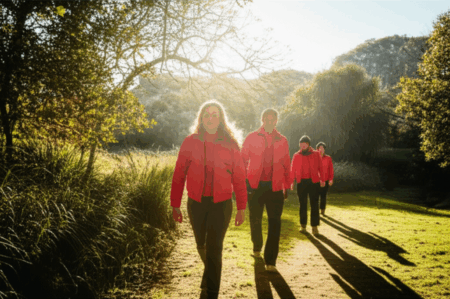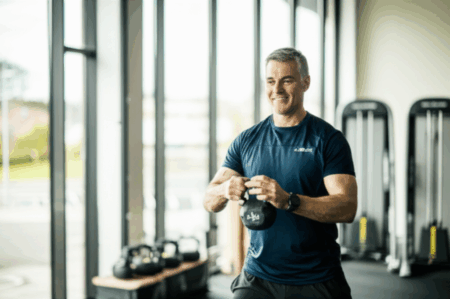For many, the thought of a high-intensity workout first thing in the morning is enough to send shivers down their spine. If you’re someone who prefers to ease into the day, you might think that morning exercise isn’t for you. However, there are plenty of gentle and energizing fitness routines that can be the perfect way to kickstart your day on a positive note. These routines focus on waking up your body and mind without the jarring effect of a strenuous workout.
Why Choose a Slow-Paced Morning Routine?
- Reduced Stress: High-intensity workouts can sometimes increase cortisol levels, the stress hormone. A gentle routine can help lower cortisol and promote relaxation.
- Improved Consistency: When you enjoy your workout, you’re more likely to stick with it. Slow-paced routines are more sustainable in the long run.
- Enhanced Mindfulness: Gentle movements and stretching can help you connect with your body and cultivate a sense of mindfulness.
- Increased Energy: While it may seem counterintuitive, a light workout can actually boost your energy levels for the day.
- Better Flexibility and Mobility: Gentle stretching improves flexibility and range of motion, making everyday tasks easier.
7 Gentle Fitness Routines to Start Your Day
Here are seven fitness routines perfect for those who prefer a slow and steady start to their day:
1. Sunrise Yoga Flow
Yoga is a fantastic way to gently wake up your body and mind. A slow-paced yoga flow focuses on stretching, breathing, and gentle movements to improve flexibility, reduce stress, and increase energy.
How to do it:
- Start with gentle stretches in bed: Cobra stretch, knees-to-chest, spinal twist.
- Sun Salutations: Perform a few rounds of sun salutations (Surya Namaskar) at a slow and mindful pace.
- Standing Poses: Include poses like mountain pose (Tadasana), tree pose (Vrksasana), and warrior poses (Virabhadrasana).
- Seated Poses: Incorporate seated poses like seated forward fold (Paschimottanasana) and spinal twist (Ardha Matsyendrasana).
- Finish with Savasana: End your practice with a few minutes of relaxation in corpse pose (Savasana).
Benefits: Improves flexibility, reduces stress, increases energy, enhances mindfulness.
2. Mindful Walking
Walking is a simple yet effective way to start your day. Mindful walking involves paying attention to your breath, your body, and your surroundings as you walk. This can help clear your mind and set a positive tone for the day.
How to do it:
- Find a quiet place to walk: This could be a park, a garden, or even your neighborhood.
- Focus on your breath: Pay attention to the sensation of your breath entering and leaving your body.
- Notice your surroundings: Observe the sights, sounds, and smells around you.
- Pay attention to your body: Notice how your body feels as you walk.
- Walk for 15-30 minutes: Aim for a moderate pace that allows you to breathe comfortably.
Benefits: Reduces stress, improves mood, increases energy, enhances mindfulness.
3. Gentle Stretching
Stretching is a great way to increase flexibility, reduce muscle tension, and improve circulation. A gentle stretching routine can help you wake up your body and prepare it for the day ahead.
How to do it:
- Start with neck stretches: Gently tilt your head from side to side and forward and back.
- Shoulder stretches: Roll your shoulders forward and backward, and stretch your arms across your body.
- Torso stretches: Twist your torso from side to side, and reach your arms overhead for a side stretch.
- Leg stretches: Stretch your hamstrings, quadriceps, and calves.
- Hold each stretch for 20-30 seconds: Breathe deeply and relax into each stretch.
Benefits: Improves flexibility, reduces muscle tension, increases circulation, enhances relaxation.
4. Tai Chi
Tai Chi is a gentle form of exercise that involves slow, flowing movements. It improves balance, coordination, and flexibility, and can also reduce stress and improve mental clarity.
How to do it:
- Find a quiet space: Choose a place where you can move freely without obstacles.
- Focus on your posture: Stand with your feet shoulder-width apart and your knees slightly bent.
- Follow a Tai Chi routine: There are many different Tai Chi routines available online or in classes.
- Move slowly and deliberately: Pay attention to each movement and focus on your breath.
- Practice for 15-20 minutes: Start with a shorter routine and gradually increase the duration as you become more comfortable.
Benefits: Improves balance, coordination, flexibility, reduces stress, enhances mental clarity.
5. Pilates
Pilates is a low-impact exercise that focuses on strengthening your core muscles, improving posture, and increasing flexibility. A gentle Pilates routine can help you wake up your body and improve your overall strength and stability.
How to do it:
- Start with basic Pilates exercises: Include exercises like the hundred, roll-ups, and leg circles.
- Focus on proper form: Pay attention to your alignment and engage your core muscles throughout each exercise.
- Breathe deeply: Coordinate your breath with your movements.
- Perform each exercise for 10-15 repetitions: Start with a smaller number of repetitions and gradually increase as you get stronger.
- Practice for 20-30 minutes: Aim for a full-body workout that targets all major muscle groups.
Benefits: Strengthens core muscles, improves posture, increases flexibility, enhances body awareness.
6. Low-Impact Cardio
If you enjoy cardio but prefer a gentler approach, low-impact cardio is a great option. This type of exercise raises your heart rate without putting excessive stress on your joints.
How to do it:
- Choose a low-impact activity: Options include walking, cycling, swimming, or using an elliptical machine.
- Warm-up for 5 minutes: Start with some light stretching or marching in place.
- Maintain a moderate intensity: Aim for a pace where you can still talk comfortably.
- Cool down for 5 minutes: Gradually decrease your intensity and stretch your muscles.
- Exercise for 20-30 minutes: Adjust the duration and intensity to your fitness level.
Benefits: Improves cardiovascular health, increases energy, boosts mood, reduces stress.
7. Dynamic Strength Exercises
Dynamic strength exercises involve movement through a range of motion, which can help improve flexibility and coordination while building strength.
How to do it:
- Squat to overhead press: This exercise works your legs, shoulders, and core.
- Push-up to renegade row: This exercise strengthens your chest, back, arms, and core.
- Deadlift to upright row: This exercise targets your back, legs, shoulders, and arms.
- Choose a light weight or use bodyweight: Focus on proper form and control.
- Perform 10-12 repetitions of each exercise: Complete 2-3 sets with a short rest in between.
Benefits: Improves strength, flexibility, coordination, increases energy, enhances overall fitness.
Tips for Creating a Successful Morning Routine
- Start small: Begin with just 10-15 minutes of exercise and gradually increase the duration as you get more comfortable.
- Be consistent: Aim to exercise at the same time each morning to establish a routine.
- Prepare the night before: Lay out your workout clothes, prepare your mat, and have a water bottle ready.
- Find an activity you enjoy: Choose a routine that you find fun and engaging so you’re more likely to stick with it.
- Listen to your body: Pay attention to how your body feels and adjust your routine accordingly.
- Stay hydrated: Drink plenty of water before, during, and after your workout.
- Be patient: It takes time to develop a habit, so don’t get discouraged if you miss a day or two.
Conclusion
Starting your day with a gentle fitness routine can be a wonderful way to boost your energy, reduce stress, and improve your overall well-being. By choosing an activity you enjoy and incorporating it into your daily routine, you can create a sustainable and fulfilling morning practice that sets you up for a successful day. Remember to listen to your body, be patient with yourself, and enjoy the process of creating a healthier and happier you.







